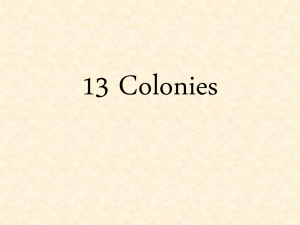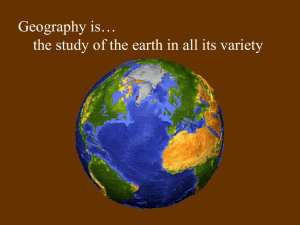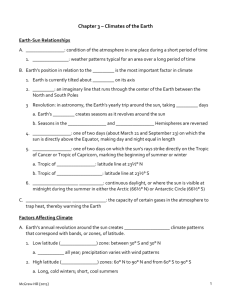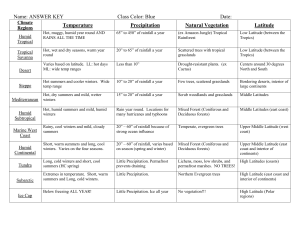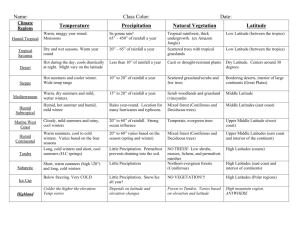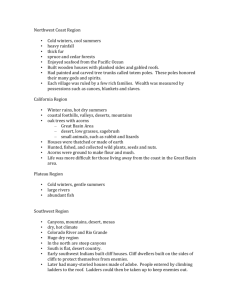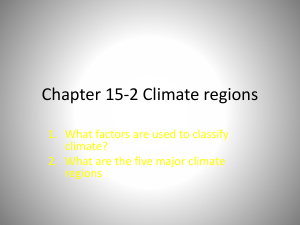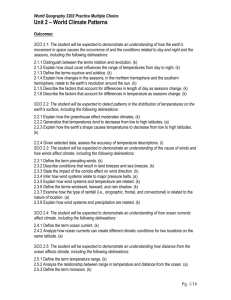MidTermReviewAnswersUnit2
advertisement
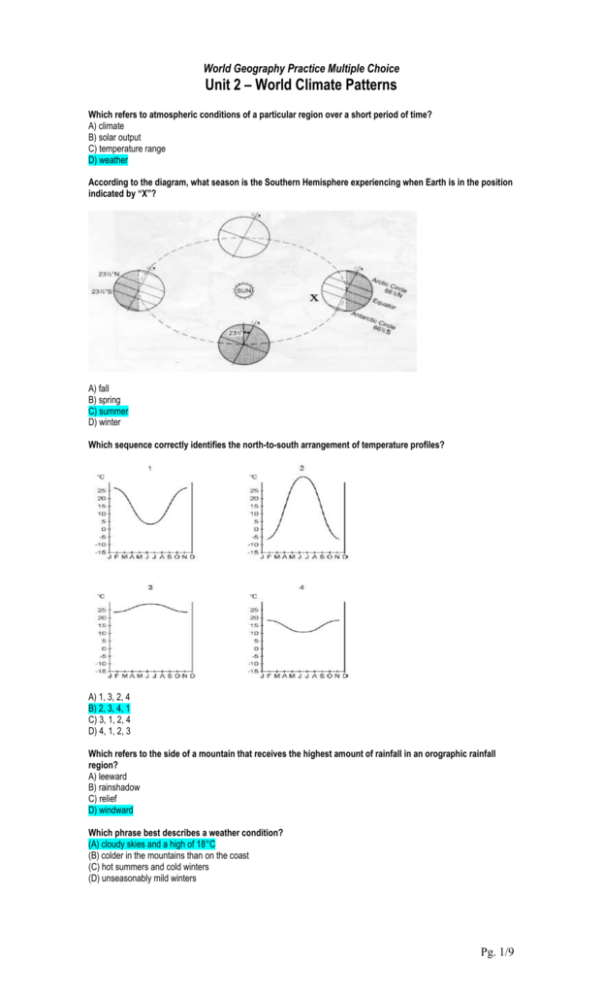
World Geography Practice Multiple Choice Unit 2 – World Climate Patterns Which refers to atmospheric conditions of a particular region over a short period of time? A) climate B) solar output C) temperature range D) weather According to the diagram, what season is the Southern Hemisphere experiencing when Earth is in the position indicated by “X”? A) fall B) spring C) summer D) winter Which sequence correctly identifies the north-to-south arrangement of temperature profiles? A) 1, 3, 2, 4 B) 2, 3, 4, 1 C) 3, 1, 2, 4 D) 4, 1, 2, 3 Which refers to the side of a mountain that receives the highest amount of rainfall in an orographic rainfall region? A) leeward B) rainshadow C) relief D) windward Which phrase best describes a weather condition? (A) cloudy skies and a high of 18°C (B) colder in the mountains than on the coast (C) hot summers and cold winters (D) unseasonably mild winters Pg. 1/9 Which type of rainfall is represented in the diagram? A) convectional B) frontal C) orographic D) relief Which refers to the height of land above sea level? A) aspect B) elevation C) relief D) topography What creates the Coriolis force? (A) Earth’s rotation (B) gravitation (C) ocean currents (D) pressure zones Which term best refers to winds that produce dry winters and wet summers? (A) easterlies (B) monsoons (C) northeast trades (D) westerlies Which diagram best illustrates prevailing wind direction in the Northern Hemisphere? A) 1 B) 2 (remember the effect of the coriolis force!!) C) 3 D) 4 Which term is defined as, “having a day and night of equal length”? (A) eclipse (B) equinox (C) lunar (D) solstice Which is true? (A) Temperature decreases as longitude decreases. (B) Temperature decreases as longitude increases. (C) Temperature increases as latitude decreases. (D) Temperature increases as latitude increases. Pg. 2/9 According to the diagram, which accounts for differences in east and west coast temperatures in South America? A) impact of northeast winds on east coast and southerly winds on west coast B) impact of northeast winds on west coast and southerly winds on east coast C) influence of warm ocean current on east coast and cold ocean current on west coast D) influence of cold ocean current on east coast and warm ocean current on west coast Which factor gives Novosibirsk a wide range of temperatures from winter to summer? A) altitude B) continentality C) latitude D) topography Which is best illustrated by: “Winds tend to deflect to the right in the Northern Hemisphere while winds in the Southern Hemisphere are deflected to the left.”? (A) corriolis force (B) earth’s rotation (C) ocean currents (D) pressure zones What is the temperature range of the climate data below? (A) -8 °C (B) 7 °C (C) 15 °C (D) 23 °C Pg. 3/9 What would be the main threat posed by climatic conditions in July if you were living in India? (A) drought (B) dust storms (C) floods (D) forest fires Which statement makes reference to weather? (A) Farmers in India welcome summer monsoon rains. (B) On February 19, 2004 Dartmouth received 96 cm of snow. (C) The summer of 2003 was a typical hot and dry season. (D) Vancouver has an annual frost-free period of 233 days. Which best describes the climate represented by the climograph below? A) cool, wet summers and mild, dry winters B) hot, dry summers and mild, wet winters C) hot, dry summers with an even distribution of precipitation D) warm, wet summers and cool, dry winters Which statement refers to climate? (A) Heavy snowfall in December resulted in 125 vehicle accidents. (B) Residents of Nova Scotia prepared for Hurricane Juan. (C) Tourists visiting Brazil enjoyed daily temperatures of 25/C during their two week stay. (D) Winnipeg, Canada has a temperature range of 38/C and average annual precipitation of 526mm. Which season is occurring in the Northern Hemisphere when Earth is at position X in the drawing? (A) fall (B) spring (C) summer (D) winter Which is defined as, “a permanent or semi-permanent horizontal movement of unusually cold or warm surface water of the oceans, to a depth of about 100m”? (A) ocean current (B) ocean tide (C) tidal wave (D) wave refraction Pg. 4/9 Which is used to refer to the type of rainfall shown in the diagram below? (A) convection (B) frontal (C) orographic (D) relief Which phrase best describes the climate presented in the graphic below? (A) hot, dry summers and mild winters (B) hot summers and cold winters with fairly evenly distributed rainfall (C) hot, wet summers and cold dry winters (D) year round heat and moisture In which location is the effect of continentality most evident? (A) (B) (C) (D) W X Y Z Which explains why only a fraction of solar radiation reaches Earth’s surface? (A) The Coriolis effect causes solar radiation to be deflected from Earth. (B) Only part of Earth is illuminated at any time by the sun. (C) Solar energy is scattered, absorbed and reflected by Earth’s atmosphere. (D) Solar radiation loses some intensity as it travels through space. Pg. 5/9 In the graphic below, which location would be expected to have the highest range of temperatures? W X Y Z (A) W (B) X (C) Y (D) Z Where would the greatest annual temperature range be found on the map below? (A) A (B) B (C) C (D) D Which description most accurately identifies the climatic conditions pictured in this climograph? (A) cool wet summers, cold dry winters (B) cool wet summers, cold wet winters (C) warm dry summers, cold dry winters (D) warm dry summers, cool wet winters Pg. 6/9 Which concept is being illustrated by the diagram below? (A) Coriolis effect (B) revolution (C) rotation (D) solstice In the graphic below, which letter location lies in a high pressure belt? (A) A (B) B (C) C (D) D Which location would experience the greatest amount of orographic rainfall? (A) A (B) B (C) C (D) D Which statement is true about wind systems? (A) Air moves from a high pressure system to a low pressure system. (B) Air moves from a low pressure system to a high pressure system. (C) North East Trade Winds move from 0o North Latitude to 23 ½ o North Latitude. (D) North East Trade Winds are found only in the Southern Hemisphere. Pg. 7/9 According to the graphic below, what season is the Southern Hemisphere experiencing when the earth is in the position indicated by "X"? (A) fall (B) spring (C) summer (D) winter Which is most directly affected by land configuration, temperature variations, and the Coriolis effect? (A) humidity (B) monsoon (C) ocean current (D) tsunamis Which term is used to refer to the type of rainfall depicted in the graphic below? (A) convectional (B) frontal (C) monsoonal (D) orographic Which corresponds to a temperature increase? (A) decrease in latitude (B) decrease in longitude (C) increase in latitude (D) increase in longitude Which contributes most to the differences in the length of day as seasons change in high latitude locations? (A) Coriolis effect (B) revolution of Earth (C) rotation of Earth (D) tilt of Earth’s axis Pg. 8/9 Which phrase describes a weather condition? (A) clear skies and a high of 19°C (B) warmer year-round on the coast than in the mountains (C) wet summers and dry winters (D) unseasonably cold winters According to the graphic below, which factor most accounts for the difference in temperature between Glasgow and Nain? (A) difference in latitudinal location (B) difference in ocean currents (C) distance from the ocean (D) effect of continentality Which phrase best describes the climate represented by the climograph in Graphic 19? (A) cool, wet summers and mild, dry winters (B) hot, dry summers and mild, wet winters (C) hot summers, cool winters, and an even distribution of rainfall (D) hot, wet summers and warm, dry winters Which term best refers to middle-latitude prevailing winds that cause mild winters and year-round precipitation? (A) easterlies (B) monsoons (C) northeast trades (D) westerlies Which conditions relate to equinox? (A) equal days and nights in both hemispheres (B) long days in the Northern Hemisphere (C) long days in the Southern Hemisphere (D) short days in both hemispheres Pg. 9/9
